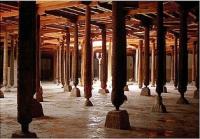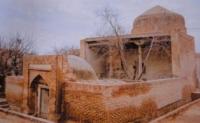Вы здесь
Mosques of Khoresm.


Religious excursions on mosques of Khoresm.
"Unbelief is that a person pretends to be a believer in something he really does not believe in."
Payne T.
Ancient Khorezm and its shrines.
А mosque- a place of prayer of Muslims, the abode revered by them, starting from the XI century has been used for specific events. Some type of mosques were intended for committing mass prayers during Islamic holidays "Kurban Khayit" (Eid al Adha) and "Uraza Khayit" (Eid al Fitra) celebrated twice a year and which was to gather a large number of of the population of cities and villages.
For such mosques called "Namazgah" a special area outside the city walls was allotted. Such mosques structurally were of frontal composition, the yard of such a mosque was not limited:-the purpose of construction of such buildings was the fact that while praying Muslims should turn their faces to the direction of Mecca (i.e. Qybla).
In Khorezm the landmark of the Qybla is the direction to the south, so in Khorezm mihrabs of the mosques (prayer niche where the Muslims turn their faces during prayer) is set in the southern wall of a building.
The "Namazgah" type of suburban mosques of standard composition in Khiva has not preserved, there is only one mosque called "Namazgah" only in Ismail Ishanbaba ensemble of Khazorasp district of Khorezm region has survived.
But it is built in the form of a broad domed hall with three-dome gallery one side of which has access to an aivan i.e. traditional architecture like mahalla mosques. Other cathedral Jum`a mosques ("Jami" - i.e. cathedral or "Jum`a" - meaning a Friday mosque) are intended for Friday prayers once a week where the majority of the Muslims of the city gathers for a prayer. In the architectural form these cathedral mosques in their majority consist of the main building which is drawn out in the longitudinal direction and a gallery on perimeter of walls.
In Khorezm the mosques of this type has not been preserved. But, according to the historical sources, they functioned in the X century in Kyat, in the XII century in Gurganj (the modern city Kunya Urgench in today’s Turkmenistan).
On carved patterned gates of the mosque Sayyed Ata of Khanqa district of Khorezm region there are written details that the mosque was built in 1749, as well as, the records of the foundation of the city.
The area around the spacious yard of the mosque is built up with aivans with wooden columns and is a complex architectural ensemble. In the early centuries of Islam mosques were intended only for for prayers, this building was a kind of popular house consecrating life of the people in all periods by variety of ceremonies, rites which is preserved in Mahalla (community) mosques that being built in crowded places and near the souks.
Their forms sharply differ from each other but despite it in their structure a single composition has been preserved: - it is a building with a small lounge limited from the front by an avian.
The hall where prayers are committed can be domed and avian in the form of domed portal gallery of an elegant monumental look or in the form of premises overlapped by the plane roof resting on wooden columns and built up by aivans.
On the southern side of mosques in Khorezm and partially Khiva in the outer part there were no apertures or openings made, as, in its inner part mihrab (prayer niche oriented towards Mecca) was located.
This fact in Khiva mosques are very seldom met, as they say, you can count on your fingers, but remained in some below listed mosques. There is domed hall with built-in one-column aivan in the mosque Yarmuhammad divan (Sayyid Ata), located near the mausoleum of Sayyid Alauddin to the southwest from the Baghbanly mosque located in the southern part of Ichan-Qala.
Ceilings of the mosques of Abdalbaba and Matriza kushbeghi are also covered by a flat roof from beams. The mosque where three sides of the prayer hall are surrounded by aivans is Aq-Mosque located next to Palvan darvaza gate of Ichan-Qala.
In front of quarter mosques in Khiva usually there is a long courtyard located where turned by its facade a high aivan of the mosque and at the opposite side, facing the aivan there stands the aivan of the darvazakhana or tars-aivan (the opposite aivan).
There also was a room (kaznak) for storage of accessories, house wares and takharatkhana (room for ablution).
Authority:
http://welcomeuzbekistan.uz







